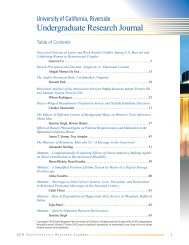UC Riverside Undergraduate Research Journal
UC Riverside Undergraduate Research Journal
UC Riverside Undergraduate Research Journal
You also want an ePaper? Increase the reach of your titles
YUMPU automatically turns print PDFs into web optimized ePapers that Google loves.
Motion Based Bird Sensing Using Frame Differencing and Gaussian Mixture<br />
Deep J. Shah<br />
its other nearest centroids. A centroid is defined to be the<br />
center of a motion detected object. The centroids found are<br />
checked to see if they match the ground truth by detecting<br />
their presence in the bounding box. A bounding box is a<br />
rectangular region covering all the edges of the detected<br />
object inside it. The size of this box is determined by the<br />
size of the object that it covers. If a centroid matches, then<br />
it is classified as a centroid inside the bounding box. If it<br />
does not match then it is classified as a centroid outside the<br />
bounding box as shown in Table 1.<br />
N<br />
Centroids inside<br />
bounding box<br />
(Average distance<br />
in pixels)<br />
Centroids outside<br />
bounding box<br />
(Average distance<br />
in pixels)<br />
1 4.0668 8.3747<br />
2 10.9104 23.4571<br />
3 20.3761 44.9948<br />
4 31.8322 74.1308<br />
5 48.9304 110.5066<br />
Table 1. Distance from a centroid to N nearest centroids in the<br />
frame showing presence of a bird.<br />
For this part, we use dilation on differentiated regions<br />
and connect them with m (m = 6 in this case) surrounding<br />
pixels. This is done to connect pixels of the same object<br />
which might have been left undetected due to the threshold<br />
value being too high. Table 2 shows the number of times<br />
a centroid is detected when the bird is present or absent in<br />
a video sequence. The value for the number of centroids<br />
detected when bird is absent in Table 2 does not include<br />
the centroids that might have been detected in frames<br />
that actually did not have any presence of bird. The final<br />
column displays total number of centroids that are detected<br />
in a given video sequence.<br />
Number of occurrences<br />
Video<br />
Sequence<br />
Number<br />
Centroid<br />
detected<br />
when bird<br />
present<br />
(TP)<br />
Centroid<br />
detected<br />
when bird<br />
absent<br />
(FP)<br />
Centroid<br />
undetected<br />
when bird<br />
present<br />
(TN)<br />
Total<br />
Centroids<br />
detected<br />
in all<br />
1 10 33 17 484<br />
2 23 106 49 545<br />
3 5 36 13 346<br />
4 11 39 24 337<br />
5 13 78 36 436<br />
Table 2. Number of true and false occurrences for bird detection<br />
using centroids.<br />
Frames 51-53 from the video sequence number<br />
4 are displayed in Figure 2. These images show the best<br />
potential accuracy of the frame differencing approach in<br />
trying to detect a moving object. The bird gets detected in<br />
these frames but the frame also detects the location of the<br />
bird in the previous frame. This is because when absolute<br />
differencing is performed between two consecutive images,<br />
the bird location in the previous frame is different from<br />
that in the current frame. This leads the algorithm to spot<br />
two birds in the differenced image. This can be seen in<br />
the center and right image of Figure 2, where a bounding<br />
box is located at the same location as bird’s location in the<br />
previous frame.<br />
Gaussian Mixture:<br />
In comparison to frame differencing, we use a<br />
conceptual approach to present the results that we obtain<br />
for Gaussian mixture application. Figure 3 shows the<br />
change in a pixel value over a range of 1000 frames. A<br />
sudden dip in the pixel value around frame number 500<br />
may represent a moving object over that pixel region and<br />
Figure 2. Application of frame differencing for bird detection. Frames 51-53 from video sequence 4 are displayed from left to right in<br />
order.<br />
50 <strong>UC</strong>R Un d e r g r a d u a t e Re s e a r c h Jo u r n a l














